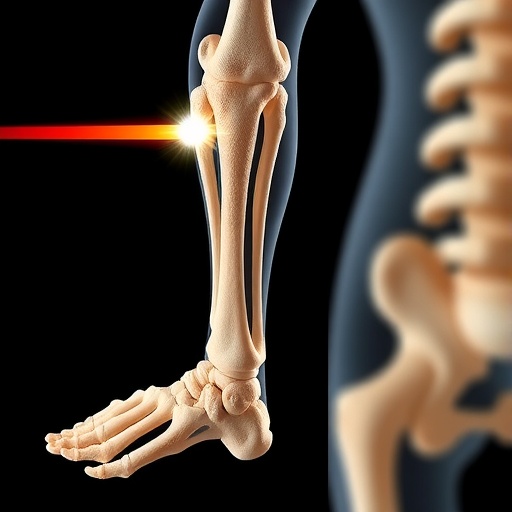Aging is an inevitable biological process marked by a complex array of cellular and molecular changes. Among the most significant and enigmatic features of aging is chronic inflammation, often termed “inflammaging.” This persistent low-grade inflammatory state plays a central role in the onset and progression of numerous age-related diseases, including neurodegenerative disorders like Alzheimer’s and Parkinson’s, as well as various forms of cancer. However, the molecular underpinnings behind why inflammation intensifies with age have remained elusive—until now. Groundbreaking research from the Stowers Institute for Medical Research, led by Associate Investigator Randal Halfmann, Ph.D., unveils a novel mechanism in our innate immune system that may explain how cells inadvertently fuel inflammation through a unique “protein puzzle” assembly process.
The innate immune system is our body’s first line of defense, an ancient and rapid-response mechanism designed to combat invading pathogens such as viruses and bacteria. This system relies on specialized proteins capable of recognizing microbial components and triggering defensive responses. Halfmann’s lab has uncovered that many of these proteins possess a peculiar structural feature known as the “death fold domain,” which drives the rapid and highly specific assembly of proteins into three-dimensional puzzle-like formations. These structures act as molecular switches, amplifying immune signals and initiating programmed cell death to restrict pathogen spread. This discovery shifts the paradigm, framing these protein assemblies as critical “batteries” that store and release energy to power immune responses.
The heart of this mechanism lies in the exquisite supersaturation of death fold proteins within cells. Rather than existing at equilibrium, these proteins are present in quantities that far exceed their solubility, placing the cellular milieu in a metastable state akin to a charged battery waiting to be discharged. Upon detection of a pathogen-derived molecular template, these supersaturated proteins rapidly coalesce into robust assemblies. This phase transition is both irreversible and highly cooperative, creating an all-or-none response that culminates in cell death and inflammation. Through state-of-the-art single-cell assays and innovative yeast model systems, the Halfmann team characterized over 100 human proteins harboring death fold domains, revealing a subset that function as these protein-phase batteries.
Intriguingly, the process that works so effectively to protect youth has an inadvertent downside. Molecular stochasticity over time introduces a risk of spontaneous, signal-independent assembly of these death fold proteins. As cells age, even in the absence of pathogens, random fluctuations can trigger puzzle formation, setting off cell death and inflammatory cascades without external provocation. This phenomenon embodies a biological “Catch-22″—the very machinery that safeguards us early in life predisposes us to chronic inflammation and tissue damage as we grow older. “We are essentially trading the certainty of survival in youth for the inevitability of aging-related degeneration,” explains Halfmann.
From a biophysical perspective, the architecture of the death fold domain enables extremely tight and selective protein-protein interactions. These domains manage to avoid accidental self-assembly through intricate folding trajectories and folding pathways that require precise molecular templates to nucleate the process. The phenomenon is reminiscent of prion-like dynamics but is functionally tuned to trigger an immune alarm rather than pathological aggregation. This molecular precision underscores the evolutionary balance struck between responsiveness and safety, enabling swift immune activation with limited false alarms—until the fidelity erodes with age.
This research not only elucidates the biochemical basis of programmed cellular demise but also offers a compelling explanation for the onset of chronic inflammatory diseases in the elderly. Many conditions previously attributed only to external insults or genetic predispositions may actually originate from intrinsic protein phase transitions within cells. If these puzzle-like assemblies could be pharmacologically modulated—either by reducing the cellular concentration of susceptible proteins or altering their folding trajectories—there lies potential to attenuate inflammaging and its downstream pathologies.
Nonetheless, the therapeutic implications present a delicate balancing act. Damping these immune batteries could inadvertently blunt necessary infection responses, heightening susceptibility to pathogens. “It’s a complex risk-benefit landscape,” notes Alex Rodríguez Gama, Ph.D., lead author of the study, “but for certain patient populations, especially those enduring chronic inflammatory diseases, accepting that tradeoff could prove transformational.” The possibility of decelerating diseases like Alzheimer’s and Parkinson’s through targeted modulation of innate immune protein assemblies sparks a new frontier in biomedical research.
Technically, the team employed an array of experimental approaches including advanced fluorescence microscopy, quantitative phase separation assays, and yeast genetics to demonstrate the supersaturation property and nucleation behavior of death fold proteins. Their multidisciplinary methodology provided unprecedented insights into protein folding kinetics in living cells, revealing how subtle shifts in cellular environments and protein concentrations can tip the balance toward pathological inflammation. This innovative research framework may catalyze further investigation into phase separation phenomena across biological systems.
Beyond elucidating aging mechanisms, this work accentuates the evolutionary logic embedded in our immune system architecture. The concept of protein phase change batteries exemplifies a strategic use of biophysical properties to achieve rapid cellular decision-making. Cells are equipped with energy reservoirs encoded in their proteome, allowing instantaneous activation of lethal inflammation upon detecting a microscopic microbial footprint. The elegance of this system reflects a sophisticated evolutionary optimization where speed and robustness predominate, albeit with a late-life cost.
Importantly, the study sets the stage for a new class of biomedical interventions targeting protein phase transitions as therapeutic nodes. Modulators that stabilize or destabilize protein conformations involved in death fold assembly could emerge as next-generation drugs to manage immune disorders and age-related inflammatory diseases. By bridging molecular biophysics with immunology and gerontology, the research pioneers a holistic understanding of how protein dynamics shape healthspan and longevity.
In conclusion, the discovery of supersaturation-driven protein assemblies as innate immune batteries reshapes our comprehension of inflammation and aging. It reveals a hitherto unappreciated tradeoff encoded in molecular structures fostered by evolutionary pressures: immediate protection against infectious disease versus the gradual ignition of chronic inflammation underpinning aging pathologies. This revelation paves the way for innovative strategies aimed at extending healthy lifespan by finely tuning our cellular “puzzle pieces” to mitigate the molecular ‘spark’ that lights the inflammatory fire.
Subject of Research: Not applicable
Article Title: Protein phase change batteries drive innate immune signaling and cell fate
News Publication Date: 16-Sep-2025
Web References:
Stowers Institute for Medical Research: http://www.stowers.org/
Halfmann Lab: https://www.stowers.org/labs/halfmann-lab
Original Study in eLife: https://doi.org/10.7554/eLife.107962.1
References:
Halfmann, R., Rodríguez Gama, A., et al. (2025). Protein phase change batteries drive innate immune signaling and cell fate. eLife. https://doi.org/10.7554/eLife.107962.1
Image Credits: Stowers Institute for Medical Research
Keywords: Inflammation, Aging, Immune system, Innate immune system, Protein folding, Protein phase separation, Cell death, Neurodegenerative diseases, Alzheimer’s, Parkinson’s, Cancer, Molecular neuroscience
Tags: aging and immune system interactioncancer and immune responsecellular mechanisms of agingchronic inflammation and aginginflammaging and age-related diseasesinflammatory response in aginginnate immune system functionmolecular biology of agingneurodegenerative disorders and inflammationprotein puzzle assembly in immune responseresearch on aging and inflammationrole of death fold domain in immunity





